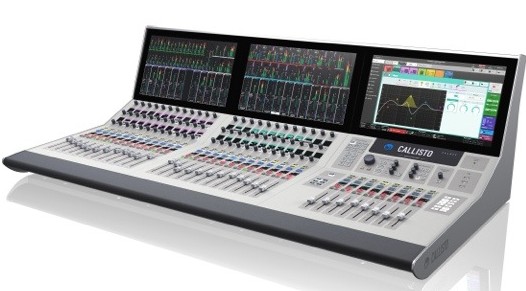Calrec Audio Announces New Broadcast Console, Callisto
Since the release of their first console in 1971, England-based Calrec Audio has dedicated their design philosophies to the broadcasting world.
Their latest console, Callisto, continues that course and has been designed with productivity in mind, allowing for straightforward operation with minimal components. The refined design also allows for less power consumption and easier maintenance access.
Along with digital displays and touch screen controls, Callisto will include a few of Calrec’s trademark console components including their Bluefin2 processing technology and Hydra2 router.
The console will be on display along with Calrec’s full line of consoles at IBC 2013 in Amsterdam, September 12th – September 17th.
Here is more from Calrec:
When designing the new console, Calrec focused on ensuring that Callisto’s highly intuitive GUI would be suitable for a broad range of operator levels. Users control the console via a 17-inch multitouch screen inspired by familiar tablet technology, with a straightforward interface that uses established finger gestures to navigate the system. The crisp, high-resolution display provides elegant controls and clear presentation of information.
Designed for live broadcast applications and with a focus on intuitive operation, Callisto simplifies even complex workflow tasks, such as creating mix-minus feeds, with common procedures that are just one tap away.
Callisto’s other large displays are fully configurable to display bus, output, and loudness meters, and feature dedicated metering, routing, and processing information per fader.
The physical control surface is available in fixed 32- and 44-fader configurations with a new streamlined layout. Each channel strip has only the most essential mechanical controls, featuring a fader, two flexible control cells, and a dedicated gain pot.
Callisto uses Calrec’s award-winning Bluefin2 technology at its core, and the same integral 8192 x 8192 Hydra2 router as the Apollo and Artemis consoles. Bluefin2 and Hydra2 technologies are in use 24 hours a day at hundreds of facilities across the globe, and are still the most advanced audio processing technologies available.
Bluefin2 provides Callisto with a pool of 180 channel processing paths, which can be assigned as mono, stereo, or 5.1 channels. As with all Calrec consoles, there is no resource-sharing across the DSP, so all facilities are available on all channels at all times. Callisto has eight groups, four mains (all of which can be mono, stereo, or 5.1), 16 auxes, and 32 tracks.
The broadcast-focused feature set also includes complete system redundancy, dedicated delay on all paths with additional assignable input and output delay, mechanical PFL overpress on all faders, and three 5.1 studio monitor outputs.
Please note: When you buy products through links on this page, we may earn an affiliate commission.







